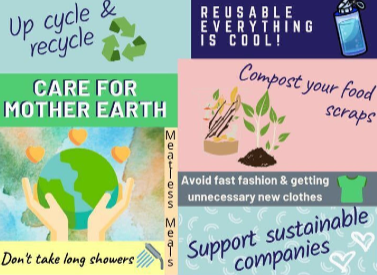As everyone remains at home and practices social distancing, it is a great opportunity to invest some of the excess time on everyone’s hands into helping the planet and practicing sustainability. This pandemic has to end at some point in the future, and in the meantime people can work on being more environmentally-conscious global citizens to ensure that when we are able to once again roam freely, the Earth is a cleaner place. The same things that will help combat climate change during quarantine will still help in the future, so developing good practices now and keeping them will help the world stay cleaner for years to come
First off, you may already be reducing your carbon footprint! By working from home, you are reducing the natural gas emissions that would have been created if you were driving or taking mass transit to school or work every day. Furthermore, since you are at home and cannot have any gatherings, you are likely to be buying fewer (if any) one-time utensils: great job! You are also likely buying fewer disposable plastic water bottles! This habit that you are developing now to drink out of more reusable bottles and eat with reusable utensils can easily be sustained after life returns to a state of normality.
There are even more sustainable habits that you can develop while at home! Former President of SAVE (Sustainability, Activism, Volunteering, & Engineering), Allyson Clark, suggests that those who are cooking more at home can learn new kitchen sustainability hacks. She recommends to, “use reusable beeswax wraps to wrap leftover food instead of saran wrap, use Pyrex Tupperware containers instead of plastic containers to reduce the use of plastic, and try to buy fewer packaged foods, such as fresh produce.” Another way to be more sustainable in the kitchen is to use reusable kitchen towels instead of paper towels; this is especially important right now as many stores are struggling to keep disposable paper products in stock. In regard to cooking more sustainably, you can use your available groceries to experiment making vegan and vegetarian recipes. Removing just one meal a week that contains meat can help greatly reduce your carbon footprint and your water footprint. The COVID-19 pandemic has also disrupted communities’ ability to recycle, so it is even more important to try to reduce the total amount of waste that your household produces and find creative ways to reuse things. To reduce food waste, try putting your scraps into a composting bin rather than throwing them out.
Just as you can act more sustainably in the kitchen, you can also do so in the bathroom! Take showers over baths to conserve water, and remain mindful of how long your showers are. If you need to purchase new bathroom products, such as toothbrushes, opt to buy products made of more sustainable materials, like bamboo. You can also take on a DIY project by purchasing some materials in bulk and learning to make zero-waste cleansing products such as soaps, toothpaste, face scrubs, and body wash.
In addition to adjusting kitchen and bathroom etiquette, there is now also time to take a hard look at your closet! Olivia Scott, Co-Chair of Festivities for the Entertainment Committee, has been doing just that! Scott suggests that while at home, people take the time to go through all of their old clothing and household items to set aside what is no longer used to donate. You can find donation criteria for GoodWill or other donation spots online and keep them in mind while you do spring cleaning. Try to not throw anything away unless it is absolutely necessary. Now is a great time to experiment with upcycling old clothes! Instead of throwing out old items, you can turn them into something new, such as a simple face cover to wear outside, or just take the time to clean something, like a pair of formerly white sneakers. If you want to reduce your need to buy more clothes in the future, you can also play around with the concept of a “capsule wardrobe,” which is essentially a small collection of versatile clothing. There are many ways to go about what your capsule wardrobe entails, and the number of each item can be changed, but one way to start is to set aside your 10 favorite and versatile tops, seven of your favorite and versatile bottoms and five pairs of versatile shoes. Ideally, your capsule wardrobe should allow you to create a plethora of different outfit combinations and prevent you from having to buy new clothes every season.
Scott and Clark are two of the key student leaders working on a social media campaign for Earth Week in lieu of the usual on-campus activities. Others can also partake in this campaign and show love for Mother Earth during this week and beyond! Take the time to read up on different parts of your life, like fashion and food, to be aware of the environmental impacts as well as what you can to decrease the negative impact. By spreading awareness about sustainability, you are able to provide helpful information, resources, and inspiration for others to try to lead a greener lifestyle. For when quarantine is over, look for different sustainability-focused organizations near you to get involved and volunteer. Most importantly, remember that now is an opportune time to break apart your former daily routine and see what aspects you can change to begin a greener lifestyle that you can practice while self-isolating and continue in the future!

Be First to Comment